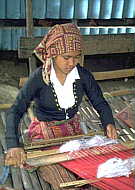
|
|

| The Yakans of Basilan Island |
 |
 |
|
A Short Introduction
The Yakans are the traditional settlers of
Basilan Island in the Southern Philippines, situated to the west of Zamboanga
in Mindanao. It is said that their typical physical characteristics are
strikingly different when compared to the other ethnic Filipino groups (relatively
high-bridged noses and tall stature). Traditionally they wear colorful,
handwoven clothes. The women wear tightfitting short blouses and both sexes
wear narrowcut pants resembling breeches. The women covers it partly
with a wrap-around material while the man wraps a sash-like
cloth around the waist where he places his weapon - usually a long knife. The Yakans settled originally in Basilan island and in the early seventies, due to political unrest which led the armed conflicts between the militant Muslims and government solders, some of them settled in the region of Zamboanga City. The Yakan Village in Upper Calarian is famous among local and foreign tourists because of their art of weaving. Traditionally, they have used plants like pineapple and abaca converted into fibers as basic material for weaving. Using herbal extracts from leaves, roots and barks, the Yakans dyed the fibers and produced colorful combinations and intricate designs. The seputangan is the most intricate design worn by the women around their waist or as a head cloth. The palipattang is patterned after the color of the rainbow while the bunga-sama, after the python. Almost every Yakan fabric can be described as unique since the finished materials are not exactly identical. Differences may be seen in the pattern or in the design or in the distribution of colors. Contacts with Christian Filipinos and the American Peace Corps brought about changes in the art and style of weaving. Many resorted to the convenience of chemical dyes and they started weaving table runners, placemats, wall decor, purses and other items which are not present in a traditional Yakan house. In other words, the natives catered because of economic reason to the needs of their customers. New designs were introduced like kenna-kenna, patterned after a fish; dawen-dawen, after the leaf of a vine; pene mata-mata, after the shape of an eye or the kabang buddi, the diamond-shaped design. A detailed description of the different designs is under preparation. This short introduction is based on a writeup by Reuben Muzarin, a Yakan, who is documenting his ancestral history and culture. We will support his project and will publish some of his papers later on. Contact Adress: Reuben Muzarin, Upper Calarian, Zamboanga City, Philippines. Websites using Yakan designs:
| ||
 European Philippine Services European Philippine Services
See also: Tourist Spots of Zamboanga City  | ||
| [Austrian-Philippine Home Page] [Culture and History] | ||
|
Document created: June 27, 1997 updated: September 8, 1998 APSIS Editor Johann Stockinger |